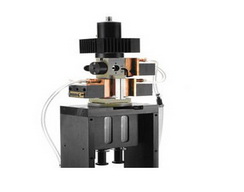


· Hot and cold jumps
· T-changes as high as several ten of degrees
· Low volume consumption
· Millisecond resolution
Principle
This new T-jump instrument achieves
temperature changes by mixing two solutions of different initial
temperatures T1 and T2. The final temperature of the mixture (T3) is
calculated from the initial temperatures T1 and T2 and the mixing ratio
of the two solutions.
Three thermoelectric Peltier elements are used to control the initial temperatures of the two solutions and that of the observation cell after mixing. The mT-jump accessory is installed on a Bio-Logic stopped-flow basis.
The system is fully controlled from the Bio-Kine32 software: the user
defines the mixing ratio for the reaction and the amplitude of the
temperature jump.
The temperature of each Peltier element is then
automatically adjusted. Automatic accumulation of shots is possible to
optimize the signal to noise ratio.
The mT-jump system is equipped with a standard Bio-Logic stopped-flow observation cell. It is compatible with all modes of observations such as circular dichroism, fluorescence, absorbance, and fluorescence anisotropy.
A complementary instrument to classical T-jump
The aim of classical T-jump instruments is to record fast heat induced relaxations of reactions. This is normally achieved by applying fast electric current pulses or more recently infrared laser pulses to the sample. Time resolution of classical T-jump can reach a few µs but the kinetics cannot be recorded for more than a few ms due to temperature dissipation, which could be a limitation in some applications. Most classical temperature jump devices are limited to 5°C and are unable to perform cooling jumps.
Bio-Logic’s mT-jump is based on Stopped-Flow technology and thus offers millisecond resolution. The amplitude of the jump is entirely controlled by the user (up to 40°C jump) and the jump can be in both directions (cooling or heating jump) which offers new investigation domains, for example: refolding studies. Protein folding and refolding can easily be studied without adding denaturant to the protein! Detection with classical T-jump instrumentation is also limited to techniques such as absorbance and fluorescence whereas mT-jump is compatible with all optical methods (including circular dichroism, FT-IR, fluorescence anisotropy…)
Specifications
Temperature control specifications
• Full software control through USB connection.
• Temperature range : +5°C / +90°C
• Precision of temperature reading: 0.01°C
• Maximum temperature jump : +/- 40°C
• Temperature stability for S1 and S2 in stationary state: < +/- 0.2°C at 80°C after 15 minutes of equilibrium.
• Temperature stability in the cuvette after the T-jump: variation < 1% per 30s
• Precision of the T-jump: defined by user calibration (down to +/- 0.1°C)
• Temperature probe is included.
Mixing specifications
• Compatible with all SFM.
• Mixing Ratio from 1/1 to 1/4.
• Sample consumption per shot : 45 µl to 220 µl.
• Dead time: depends on cuvette, stopped-flow model and mixing ratio (0.7ms using SFM-2000 series and FC-08 cuvette)
• compatible with MOS-200, MOS-450/AF-CD, Diode Array detector and external devices.
• optional FT-IR cell.